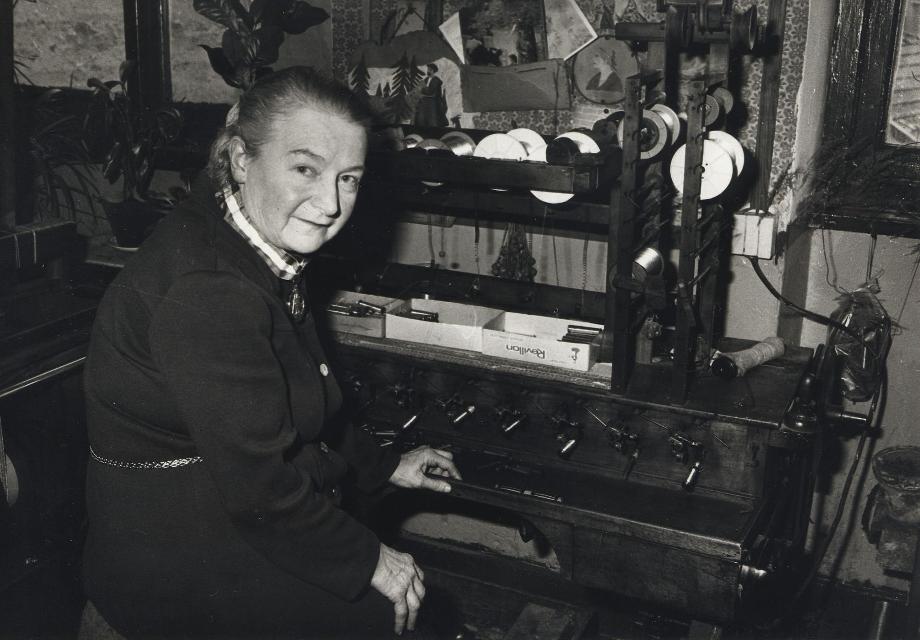The municipal trimmingS workshop
 The municipal trimmings workshop is the former workshop-apartment of Madame Létourneau (one of the last real canut-house workshops in Croix-Rousse). Soierie Vivante presents the imposing trimmings looms, in crafted walnut, present in the workshop for more than a century.
The municipal trimmings workshop is the former workshop-apartment of Madame Létourneau (one of the last real canut-house workshops in Croix-Rousse). Soierie Vivante presents the imposing trimmings looms, in crafted walnut, present in the workshop for more than a century.
Two looms are original (Mrs. Létourneau notably made braids for the army on these looms), the third is a loom which produced woven images. Made at Croix Rousse at the end of the 19th century, it was used in the Loire by Monsieur Dumas, a trimmer.
The workshop also has an exceptional trimmings craft, dating from the 1750s, which can make a ribbon using numerous steps. A braiding machine completes the machine collection.
During the visit, watch the looms operated in front of you, understand the tricks of weaving and the genius of Jacquard's invention.
Guided tours all year round : Tuesday to Saturday, 2 p.m. and 4 p.m., without reservation, 21 rue Richan 69004 Lyon

The story of Mrs Létourneau and her trimmings workshop
by Hélène Carleschi
Take a few minutes to discover the life and journey of the former owner of the trimmings workshop :
Ms. Henriette Létourneau
MRs. LÉtourneau,
a life on the job
 Mrs. Létourneau, born Henriette Dunoyer, was born in 1912 in the workshop, and died in 2005.
Mrs. Létourneau, born Henriette Dunoyer, was born in 1912 in the workshop, and died in 2005.
It was his father Jean-Claude Dunoyer, who came from his native Saône et Loire, who settled in Croix-Rousse, going from street to street and from workshop to workshop to complete his training as a passementier... On December 24, 1909, he set up shop on rue Richan, with trimmings looms manufactured in the 1880s and which were later equipped with electric motors.
Shortly after her birth, Henriette lost her two brothers, victims - like so many others - of the 1914 war. In 1925 she had to give up her career as a teacher and work with her parents; This lasted for 54 years, with twelve-hour days, standing, busying himself around his two jobs.
When she became Madame Létourneau, she bought the workshop on Rue Richan and benefited from some help from her husband, who retired in 1975. In 1976, she won the Meilleur Ouvrier de France competition with the Gold Medal.
She worked for silk houses in Lyon (in particular the Duviard house) and supplied them with church ornaments or military braids sold all over the world (on both sides of the Iron Curtain!), but the markets were shrinking and when, in 1978, Madame Létourneau retired, there were only 5 trimmers left in Croix-Rousse (instead of 1500 in 1928).
She did everything she could to save her workshop from destruction in 1993, and took the steps to open it to the public with the help of the municipality. These are the origins of the creation of the Soierie Vivante association.
Trimmings:
Weaving braids

Trimmings take their name from the old term "passements", which referred to narrow pieces used for the ornamentation of clothing or furniture (embroidery, cords), up to 30 centimetres wide.
The so-called "Zurich-style" trimmings can reproduce several small widths on the same structure. The production is large and fast, they are the object of a real trade. As far as this workshop was concerned, the outlets were very wide (two-thirds of the production was destined for export) in three main areas: military braids, religious ornaments and furniture.
On the looms presented in the workshop at 21 rue Richan, up to 18 pieces of narrow fabric are woven side by side.
For each one, we start with a warp guided from the back to the front of the loom by a set of spools, pulleys and combs, and a transverse weft deposited by one or more shuttles containing a bobbin loaded with thread and animated by a back and forth movement.
The crossing of the threads and the design made are controlled by a series of perforated cardboard, read by the Jacquard mechanism, which is placed above the loom. The cardboard, made according to the original design, is perforated, which allows a set of needles and hooks to lift part of the warp threads to open a passage for the weft thread. This allows you to vary the width and colours of the fabrics.
The richness of the fabrics is a function of the threads used, often gold and silver yarns prepared by the guimperie workshop, which was next door to 21 rue Richan.

















